What'sNEW Jan - Apr 2020
| 30 Apr 2020 |
What'sNEW about HGT | | |
 Phytoplankton pangenome reveals extensive prokaryotic horizontal gene transfer of diverse functions by Xiao Fan et al., Science Advances, 29 Apr 2020. Our results substantially expand the impact of HGT in eukaryotes and define a set of general principles for prokaryotic gene fixation in phytoplankton genomes. Phytoplankton pangenome reveals extensive prokaryotic horizontal gene transfer of diverse functions by Xiao Fan et al., Science Advances, 29 Apr 2020. Our results substantially expand the impact of HGT in eukaryotes and define a set of general principles for prokaryotic gene fixation in phytoplankton genomes.
 Thanks, Newswise. Thanks, Newswise.
 Mars Meteorite Found in Antarctica: a 2-minute retrospective video about ALH84001, narrated by Hannake Weitering, Space.com, viewed 30 Apr 2020. Mars Meteorite Found in Antarctica: a 2-minute retrospective video about ALH84001, narrated by Hannake Weitering, Space.com, viewed 30 Apr 2020.
 Thanks, Ronnie McGhee. Thanks, Ronnie McGhee.
 Life on Mars! has history and updates. Life on Mars! has history and updates.
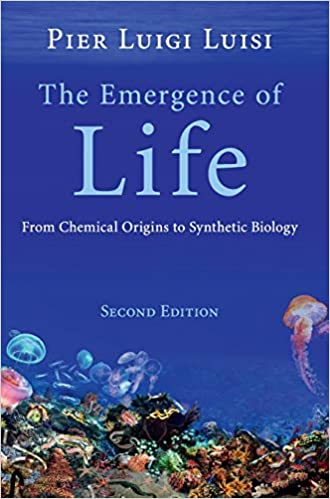 The Emergence of Life has the most thorough discussion we have ever read on this topic. The various avenues of research get full and deep, updated presentation, enhanced with pictures, graphs and tables. Author Pier Luigi Luisi often includes conversations with primary research specialists when their fields are under discussion. Luisi is a biochemist at the University of Rome and a hands-on primary researcher himself, so he knows them.
The Emergence of Life has the most thorough discussion we have ever read on this topic. The various avenues of research get full and deep, updated presentation, enhanced with pictures, graphs and tables. Author Pier Luigi Luisi often includes conversations with primary research specialists when their fields are under discussion. Luisi is a biochemist at the University of Rome and a hands-on primary researcher himself, so he knows them.
Luisi cares about the philosophy underlying the research and has much to say about topics like contingency vs. necessity, the role of religion, the definition of life, autopoiesis, synthetic biology, and minimal life. The Subject index contains about 400 entries, including one for panspermia.
"The hardware" is the title of Chapter 2. This makes us hopeful that the software problem will get equal treatment. Indeed, Luisi frequently mentions the difficulty of creating or finding long-enough, properly sequenced chains of amino-acids and nucleotides. But nothing more in the 11 chapters. Naturally, a biochemist will know the hardware better. And perhaps there's nothing more to say about the software anyway (because it seems to have come from nowhere!)
This book is a big resource: 37 pages of references, c. 300 entries in the Names index, and – our favorite – a 15-page Appendix of open questions. Luisi is convinced that life originated on Earth, but every chapter mentions difficulties and unknowns. He is a thoughtful, probing, skeptical origin-of-life scientist. We wish he would take a closer look at cosmic ancestry.
 The Emergence of Life: From Chemical Origins to Synthetic Biology, Second Edition, by Pier Luigi Luisi, 478 pages, Cambridge University Press, 2016 [ToC with linked summaries]. The Emergence of Life: From Chemical Origins to Synthetic Biology, Second Edition, by Pier Luigi Luisi, 478 pages, Cambridge University Press, 2016 [ToC with linked summaries].
 Thanks for your help, Katrina Halliday. Thanks for your help, Katrina Halliday.
 The RNA World: and Other Origin-of-Life Theories has background and updated links. The RNA World: and Other Origin-of-Life Theories has background and updated links.
 Computer Models of Evolution discusses the software problem. Computer Models of Evolution discusses the software problem.
An analysis of one problem for the origin of life via the RNA world comes from an astronomer at The University of Tokyo. He begins with the beliefs that life originated on Earth, and that the universe originated in an inflationary big bang. He adds that this universe is likely just one among many, but his analysis pertains to only this one. He wants to show that abiogenesis via the RNA world is possible.
Replicase activity is the first essential property of life, he observes. RNA polymers of 100 nucleotides or so exhibit this activity, but replicative ones of only 40-60 nucleotides may exist. Even if so, forming a continuous RNA strand only that long is a problem. It's difficult because the nucleotides tend to aggregate. The fortuitous formation of one or two long-enough polymers he calls an abiogenesis event. After mathematical analysis, he concludes, ...the expected number of abiogenesis events is much smaller than unity when we observe a star, a galaxy, or even the whole observable universe. But if this entire universe is larger than the observable one by a factor of 10^78 or so, then, a long-enough RNA polymer becomes likely somewhere within it. That's how an abiogenesis event is possible.
Seriously.
 Emergence of life in an inflationary universe (Open Access), by Tomonori Totani, Scientific Reports, 03 Feb 2020. Emergence of life in an inflationary universe (Open Access), by Tomonori Totani, Scientific Reports, 03 Feb 2020.
 The RNA World: and Other Origin-of-Life Theories has background and updated links. The RNA World: and Other Origin-of-Life Theories has background and updated links.
 Thanks, Theodore Rigley. Thanks, Theodore Rigley.
If coronavirus spreads only from person-to-person, each carrier will introduce mutations and transmit a slightly altered version to the pool. As rounds of infection multiply, accumulated mutations should increasingly vary the viral nucleotide sequences. For example, sequences from Wuhan should differ measurably from ones from New York.
Advocates of panspermia think the virus initially arrives airborne. If so, global distribution will be more rapid and whole communities will be exposed at once. In that case, sequences from around the world would be more similar than if person-to-person infection is primary. To compare the two scenarios, many complete sequences are needed. The lack of them is frustrating to outspoken Australian immunologist and fellow panspermia advocate Ted Steele.
 Dr. Ted Steele Talks by George Howard, Cosmic Tusk, 16 Apr 2020. Dr. Ted Steele Talks by George Howard, Cosmic Tusk, 16 Apr 2020.
 17-19 Apr: Chandra Wickramasinghe: atmospheric transmission | Ted Steele: sequencing and testing | Reg Gorczynski: widespread exposure | Brig Klyce: mutations; and 17-19 Apr: Chandra Wickramasinghe: atmospheric transmission | Ted Steele: sequencing and testing | Reg Gorczynski: widespread exposure | Brig Klyce: mutations; and
 24 Apr 2020: more from Gorczynski on Italy. 24 Apr 2020: more from Gorczynski on Italy.
...if evolution by natural selection is to occur, functional proteins must form a continuous network which can be traversed by unit mutational steps without passing through nonfunctional intermediates. In this respect, functional proteins resemble four-letter words in the English language, rather than eight-letter words, for the latter form a series of small isolated islands in a sea of nonsense sequences. — "Natural Selection and the Concept of a Protein Space" by John Maynard Smith, Nature, 07 Feb 1970.
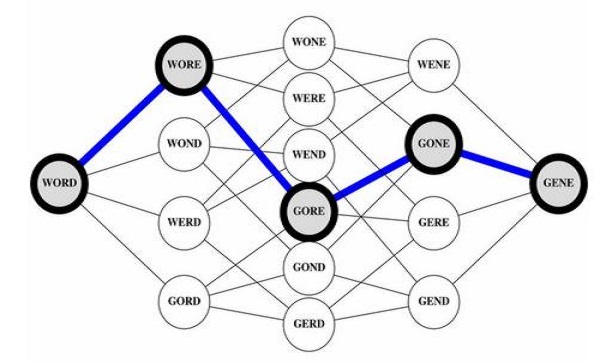
Evolutionary biologist Brandon Ogbunugafor quotes this passage in a thoughtful, open-access review. He especially appreciates what Maynard Smith's article "can teach us about the art of constructing useful and subversive analogies" (subversive?). Now, fifty years later, functional proteins look more like sentences with forty-letter words, and evolutionary theorists no longer depend on point mutations except for optimization within narrow ranges.
Maynard Smith also wrote about major transitions in evolution. These would require, to sustain the analogy, whole new sentences, paragraphs, chapters and volumes. Nowadays, evolutionary theorists take words and sentences as given, and rely on fortunate acquisitions and rearrangements of them for the new paragraphs and chapters. This scenario is appealing, but it is incomplete. It does not account for the words and sentences, nor the software that handles them. In any case, today's dawinism suffers from a glaring lack of experimental support for its most important claims. Even a computer model, in principle, could demonstrate these claims, but that's also lacking.
Before long, the commemoration praises Maynard Smith for his "unambiguous rebuttal" of creationism/intelligent design (the subversives?). And gridlock still paralyzes evolutionary theory. There must be another way.
 A Reflection on 50 Years of John Maynard Smith's 'Protein Space' (Open Access), by C. Brandon Ogbunugafor, doi:10.1534/genetics.119.302764, Genetics, 01 Apr 2020. A Reflection on 50 Years of John Maynard Smith's 'Protein Space' (Open Access), by C. Brandon Ogbunugafor, doi:10.1534/genetics.119.302764, Genetics, 01 Apr 2020.
 Neo-Darwinism... is our main related webpage, with discussion and links about fitness landscapes. Neo-Darwinism... is our main related webpage, with discussion and links about fitness landscapes.
 The Evolution Prize confronts the lack of evidence. The Evolution Prize confronts the lack of evidence.
 Evolution vs Creationism elaborates on the gridlock. Evolution vs Creationism elaborates on the gridlock.
Some Assembly Required by Neil Shubin is a deep resource about the mainstream theory of evolution. In episodes with quirky anecdotes Shubin describes breakthroughs in protein sequencing, embryology, gene regulation, molecular clocks, "junk" DNA, convergent evolution, symbiogenesis and more. The dozens of scientists who made discoveries in these fields come brightly to life in his telling.
The general theme is that genetic programs already in existence get rearranged to produce macroevolutionary advances. Thus, what may look miraculous is actually rather simple; only some easy assembly is required.
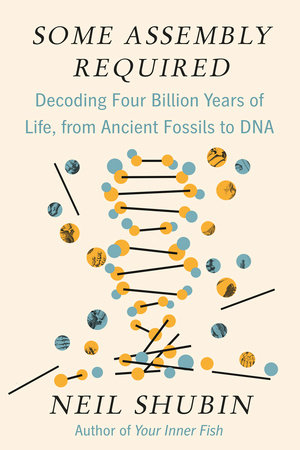 We welcome his observation that many genetic programs come from viruses. Nowhere does Shubin suggest that selection pressure caused any program to be invented on a blank slate (hooray!) And we were intrigued to know that William Bateson coined the term genetics, before the word gene was in use. The book is full of delight like that.
We welcome his observation that many genetic programs come from viruses. Nowhere does Shubin suggest that selection pressure caused any program to be invented on a blank slate (hooray!) And we were intrigued to know that William Bateson coined the term genetics, before the word gene was in use. The book is full of delight like that.
"Nothing, of course, begins at the time you think it did," wrote playwright Lillian Hellman. It is Shubin's favorite sentence, because it captures the point that genetic programs were already available before each macroevolutionary advance. And we agree, they were. But Shubin somehow believes the story is now complete. He is not surprised if, for example, hundreds of genes, all required for placental birth, were acquired at different times from viruses, and properly coordinated and deployed. The new capability was enabled simply "by a change of function," as Darwin wrote. Luckily, programming for the new function was there all along.
But this sounds miraculous. How did the programming get there?
Genetic programming that precedes its own deployment needs a source such as cosmic ancestry. Without that, for just an enjoyable, edifying, up-to-date history of the consensus neo-darwinian theory of evolution, Shubin's book is excellent.
 Some Assembly Required: Decoding Four Billion Years of Life, from Ancient Fossils to DNA by Neil Shubin, ISBN 9781101871331, Pantheon Books, 17 Mar 2020. Some Assembly Required: Decoding Four Billion Years of Life, from Ancient Fossils to DNA by Neil Shubin, ISBN 9781101871331, Pantheon Books, 17 Mar 2020.
 Neo-Darwinism... is our related webpage with updated links. Neo-Darwinism... is our related webpage with updated links.
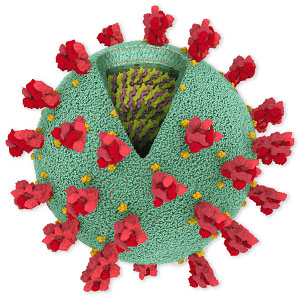
 Viruses are part of evolution, Chandra Wickramasinghe interviewed by Predrag Slijepcevic (+Cosmic Tusk), 08 Apr 2020. Viruses are part of evolution, Chandra Wickramasinghe interviewed by Predrag Slijepcevic (+Cosmic Tusk), 08 Apr 2020.
 Sickness from Space? by Seth Shostak, SETI Institute, 07 Apr 2020. Sickness from Space? by Seth Shostak, SETI Institute, 07 Apr 2020.
 Thanks, Google Alerts. Thanks, Google Alerts.
 Influenza from Space? has background. Influenza from Space? has background.
 The entire sequence of the Coronavirus Genome, with explanation and illustrations by Jonathan Corum and Carl Zimmer, The New York Times, 03 Apr 2020. The entire sequence of the Coronavirus Genome, with explanation and illustrations by Jonathan Corum and Carl Zimmer, The New York Times, 03 Apr 2020.
 Thanks, Nature Briefing. Thanks, Nature Briefing.
 Viruses... has a primer and updates. Viruses... has a primer and updates.
...the communities ...in subseafloor basalt on Earth provide a clear model for extant life and/or biosignatures from past life in the subsurface of Mars and other planets.
 Deep microbial proliferation at the basalt interface in 33.5-104 million-year-old oceanic crust by Yohey Suzuki et al., doi:10.1038/s42003-020-0860-1, Communications Biology (Open Access), 02 Apr 2020. Deep microbial proliferation at the basalt interface in 33.5-104 million-year-old oceanic crust by Yohey Suzuki et al., doi:10.1038/s42003-020-0860-1, Communications Biology (Open Access), 02 Apr 2020.
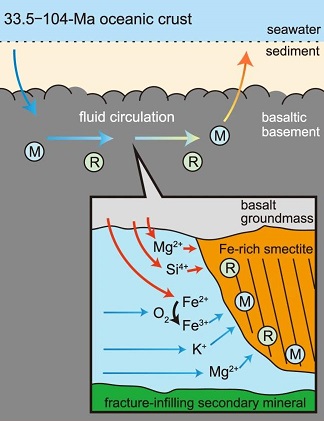 ...researchers have discovered living cells inside exceedingly old, cold oceanic crust in the middle of the South Pacific. It isn't yet clear how these new microbes are managing to survive–and yet, there seem to more than a million times more of them, for the same volume of rock, than in the younger crust.
...researchers have discovered living cells inside exceedingly old, cold oceanic crust in the middle of the South Pacific. It isn't yet clear how these new microbes are managing to survive–and yet, there seem to more than a million times more of them, for the same volume of rock, than in the younger crust.
 Bizarre life-forms found thriving in ancient rocks beneath the seafloor by Robin George Andrews, National Geographic, 02 Apr 2020. Bizarre life-forms found thriving in ancient rocks beneath the seafloor by Robin George Andrews, National Geographic, 02 Apr 2020.
 Bacteria in rock deep under sea inspire new search for life on Mars, MarsDaily, 03 Apr 2020. Bacteria in rock deep under sea inspire new search for life on Mars, MarsDaily, 03 Apr 2020.
 Thanks, Ronnie McGhee and Stan Franklin. Thanks, Ronnie McGhee and Stan Franklin.
 Life on Mars! has history and updates. Life on Mars! has history and updates.
 Bacteria... has more about their hardiness. Bacteria... has more about their hardiness.
 Extraterrestrial ribose and other sugars in primitive meteorites by Yoshihiro Furukawa et al., doi:10.1073/pnas.1907169116, PNAS, 03 Dec 2019. The detection of ribose and other bioessential sugars in NWA 801 and Murchison that are isotopically distinct from terrestrial sugars provides clear evidence of an extraterrestrial origin for these sugars in primitive meteorites. Extraterrestrial ribose and other sugars in primitive meteorites by Yoshihiro Furukawa et al., doi:10.1073/pnas.1907169116, PNAS, 03 Dec 2019. The detection of ribose and other bioessential sugars in NWA 801 and Murchison that are isotopically distinct from terrestrial sugars provides clear evidence of an extraterrestrial origin for these sugars in primitive meteorites.
 Comets: The Delivery System has background. Comets: The Delivery System has background.
SSoCIA 2020, a conference planned for 26-29 March, in Oxford MS, is cancelled because of the Corona virus. We were going to present there a poster about evidence for past metazoan life on Mars.
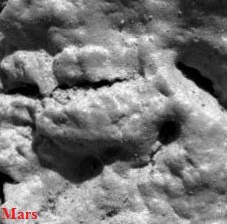
 Sea Lilies on Ancient Mars pdf | docx (close to return). For pointing arrows see: Sea Lilies on Ancient Mars pdf | docx (close to return). For pointing arrows see:
 NASA Microscopic Imager photo, Mars, 27 Feb 2004 (close to return). NASA Microscopic Imager photo, Mars, 27 Feb 2004 (close to return).
 28 Oct 2015: Discussion and links about this fossil evidence. 28 Oct 2015: Discussion and links about this fossil evidence.
 SSoCIA 2020: conference webpage, The Society for Social and Conceptual Issues in Astrobiology. SSoCIA 2020: conference webpage, The Society for Social and Conceptual Issues in Astrobiology.
 ...organic molecules discovered by Curiosity Rover consistent with early life on Mars by Sara Zaske, Washington State University (+PhysOrg.com), 05 Mar 2020. ...organic molecules discovered by Curiosity Rover consistent with early life on Mars by Sara Zaske, Washington State University (+PhysOrg.com), 05 Mar 2020.
 Life on Mars! has lots more. Life on Mars! has lots more.
 Thanks, Rob Cooper. Thanks, Rob Cooper.
...the first report of a protein from any extra-terrestrial source. It's not just disconnected amino acids or short polymers, but a longer protein-like polymer that incorporates iron and lithium. The iron oxide grouping at the tips of the molecule is of a type studied in other contexts for the photo-splitting of water.
Could the protein be a remnant of cellular life?
 Hemolithin: a Meteoritic Protein containing Iron and Lithium by Malcolm. W. McGeoch, Sergei Dikler, Julie E. M. McGeoch, arXiv, 22 Feb 2020. Hemolithin: a Meteoritic Protein containing Iron and Lithium by Malcolm. W. McGeoch, Sergei Dikler, Julie E. M. McGeoch, arXiv, 22 Feb 2020.

 Protein discovered inside a meteorite by Bob Yirka, Phys.org, 03 Mar 2020. Protein discovered inside a meteorite by Bob Yirka, Phys.org, 03 Mar 2020.
 ...alien protein inside a meteorite? by Leah Crane, NewScientist, 03 Mar 2020. ...alien protein inside a meteorite? by Leah Crane, NewScientist, 03 Mar 2020.
 Thanks, Martin Langford, Jerry Chancellor and Stan Franklin. Thanks, Martin Langford, Jerry Chancellor and Stan Franklin.
 Comets: The Delivery System has a primer and updates. Comets: The Delivery System has a primer and updates.
 James Powers has reservations about this report, 07 Mar 2020. James Powers has reservations about this report, 07 Mar 2020.
 Earth may have been a 'water world' 3bn years ago... by Ian Sample, The Guardian, 02 Mar 2020; re: Earth may have been a 'water world' 3bn years ago... by Ian Sample, The Guardian, 02 Mar 2020; re:
 Limited Archaean continental emergence reflected in an early Archaean 18O-enriched ocean by Benjamin W. Johnson and Boswell A. Wing, Nature Geoscience, 02 Mar 2020. Limited Archaean continental emergence reflected in an early Archaean 18O-enriched ocean by Benjamin W. Johnson and Boswell A. Wing, Nature Geoscience, 02 Mar 2020.
 Gaia is related. Gaia is related.
How has Coronavirus spread? There is reason to doubt that person-to-person contagion sufficiently explains it. Some recent cases followed no apparent exposure to a human carrier. Passengers, confined to quarters on a cruise ship, caught the virus at an unaccountably high rate. The worldwide spread seems too rapid. To advocates of panspermia, another unproven theory should not be automatically dismissed. Perhaps the virus is originally airborne, having arrived from space with cometary dust. (If so, at sea, perhaps passengers and crew would inhale ocean spray loaded with viruses that have accumulated on the surface of the water.)
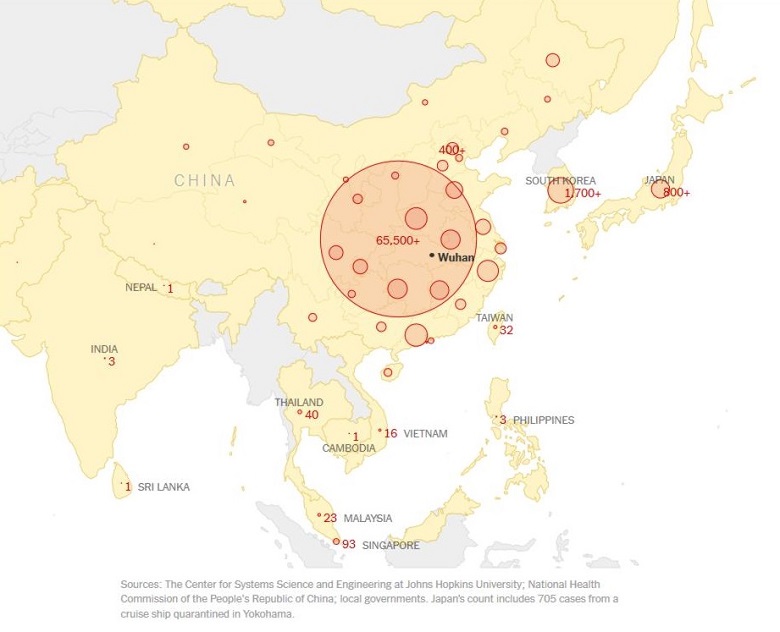 Interestingly, the flu often seems to come from China — Hong Kong Flu, Asian Flu, and now COVID-19. Hoyle and Wickramasinghe had an intriguing hypothesis to explain this. Viral particles landing as cometary dust from above the atmosphere could take a year or more to drift down to Earth's surface. Wind turbulence can speed this up. The jetstream must bounce high in the stratosphere to pass over the Himalayas, Earth's tallest mountains. Downwind, the jetstream would descend again over the plain of China. There viral particles from space would likely first make landfall.
Interestingly, the flu often seems to come from China — Hong Kong Flu, Asian Flu, and now COVID-19. Hoyle and Wickramasinghe had an intriguing hypothesis to explain this. Viral particles landing as cometary dust from above the atmosphere could take a year or more to drift down to Earth's surface. Wind turbulence can speed this up. The jetstream must bounce high in the stratosphere to pass over the Himalayas, Earth's tallest mountains. Downwind, the jetstream would descend again over the plain of China. There viral particles from space would likely first make landfall.
 Fred Hoyle and Chandra Wickramasinghe, Diseases from Space [5Mb local PDF], J.M. Dent and Sons Ltd., 1979. Fred Hoyle and Chandra Wickramasinghe, Diseases from Space [5Mb local PDF], J.M. Dent and Sons Ltd., 1979.
 Fred Hoyle, Chandra Wickramasinghe and John Watkins, Viruses from Space [5Mb local PDF], University College Cardiff Press, 1986. Fred Hoyle, Chandra Wickramasinghe and John Watkins, Viruses from Space [5Mb local PDF], University College Cardiff Press, 1986.
 07 Feb 2018: Every day, more than 800 million viruses... 07 Feb 2018: Every day, more than 800 million viruses...
 04 Feb 2020: more from Wickramasinghe, Steele et al. 04 Feb 2020: more from Wickramasinghe, Steele et al.
 Greg Irwin comments; discussion ensues, 29 Feb 2019. Greg Irwin comments; discussion ensues, 29 Feb 2019.
 Coronavirus tracking website by Avi Schiffmann. Coronavirus tracking website by Avi Schiffmann.
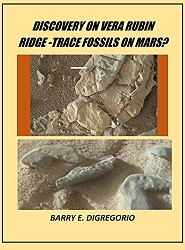 Did NASA's Curiosity rover photograph trace fossils on Mars? Barry DiGregorio thinks so. In a new book he analyzes enigmatic dark-toned features seen in Gale crater, comparing them to fossilized worm burrows on Earth. He also sees more evidence on Mars for "desert varnish," a biofilm that he has studied for years. He tells the story first-person, sometimes frustrated that NASA ignores promising leads. But his close attention to these forms on Mars and to Earthly trace fossils that look similar is, to our knowledge, unmatched.
Did NASA's Curiosity rover photograph trace fossils on Mars? Barry DiGregorio thinks so. In a new book he analyzes enigmatic dark-toned features seen in Gale crater, comparing them to fossilized worm burrows on Earth. He also sees more evidence on Mars for "desert varnish," a biofilm that he has studied for years. He tells the story first-person, sometimes frustrated that NASA ignores promising leads. But his close attention to these forms on Mars and to Earthly trace fossils that look similar is, to our knowledge, unmatched.
 Discovery on Vera Rubin Ridge - Trace Fossils on Mars? [Kindle version at Amazon], by Barry E. DiGregorio, 07 Feb 2020. Discovery on Vera Rubin Ridge - Trace Fossils on Mars? [Kindle version at Amazon], by Barry E. DiGregorio, 07 Feb 2020.
 Life on Mars! has background and more. Life on Mars! has background and more.
| 20 Feb 2020 |
What'sNEW about HGT | | |
Orphan genes do not often emerge from the divergence of predecessor genes. Instead, they must be found de novo (ready for action, in previously silent DNA) or be delivered by horizontal transfer (HGT). This conclusion comes in a lengthy new analysis by three distinguished geneticists from Trinity College Dublin and the University of Pittsburgh. The persistent presence of orphans and TRGs [taxonomically restricted genes] in almost every genome studied to date despite the growing number of available sequence databases demands an explanation. Studies in the past 20 years have mainly pointed to two mechanisms: de novo gene emergence and sequence divergence of a pre-existing gene, either an ancestrally present or one acquired by horizontal transfer. ...[W]e conclude that the origin of most genes without similarity cannot be attributed to divergence beyond recognition. This implies a substantial role for other evolutionary mechanisms such as de novo emergence and horizontal gene transfer....
 Synteny-based analyses indicate that sequence divergence is not the main source of orphan genes by Nikolaos Vakirlis, Anne-Ruxandra Carvunis and Aoife McLysaght, eLife, 18 Feb 2020. Synteny-based analyses indicate that sequence divergence is not the main source of orphan genes by Nikolaos Vakirlis, Anne-Ruxandra Carvunis and Aoife McLysaght, eLife, 18 Feb 2020.
 "Genetic Novelty: How new genes are born" [link], by Urminder Singh and Eve Syrkin Wurtele, doi:10.7554/eLife.55136, eLife 2020;9:e55136, 19 Feb 2020. "Genetic Novelty: How new genes are born" [link], by Urminder Singh and Eve Syrkin Wurtele, doi:10.7554/eLife.55136, eLife 2020;9:e55136, 19 Feb 2020.
We have long advocated HGT for supplying all "new" genes. If these remain dormant for many generations and an HGT source is not apparent, instead they will be designated de novo, provenance unknown. But if, as supposed, such genes are ancestrally present without HGT, in DNA that was never-deployed in the new role, yet is now somehow ready for optimizing selection, we have a question: Where does the programming come from? Regarding the few orphans that these geneticists think may have gradually, completely diverged from unrecognizable predecessors ...same question.
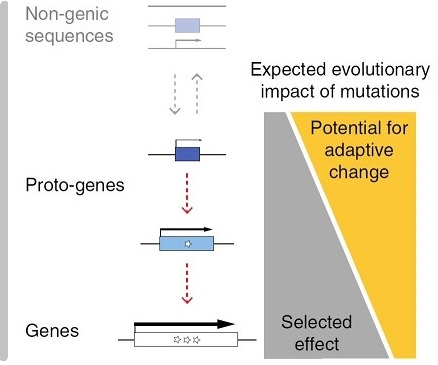
An attempt to answer our question also comes from these researchers and their affiliates. Overall, our results support an experiential model for de novo gene birth whereby a fraction of incipient proto-genes can subsequently mature and, as adaptive changes engender novel selected effects, progressively become established in genomes in a species-specific manner (see illustration). However, ...while emerging sequences show no evidence of encoding a useful protein product in the present state of the organism, they have the potential to do so in the future. We await the news.
 De novo emergence of adaptive membrane proteins from thymine-rich genomic sequences, doi:10.1038/s41467-020-14500-z, by Nikolaos Vakirlis et al., Nature Communications, 07 Feb 2020. De novo emergence of adaptive membrane proteins from thymine-rich genomic sequences, doi:10.1038/s41467-020-14500-z, by Nikolaos Vakirlis et al., Nature Communications, 07 Feb 2020.
We are pleased that orphan genes are increasingly recognized for their ubiquity and importance. And we welcome the close scrutiny of gradual divergence. We think its power is limited to microevolution.
 Genes from scratch - far more common and important than we thought, Trinity College Dublin (+PhysOrg.com), 17 Feb 2020, and Genes from scratch - far more common and important than we thought, Trinity College Dublin (+PhysOrg.com), 17 Feb 2020, and
 New and Maybe Important, Genome Web, 19 Feb 2020. New and Maybe Important, Genome Web, 19 Feb 2020.
 Where Do New Genes Come From? by Viviane Callier, Quanta, 09 Apr 2020. Where Do New Genes Come From? by Viviane Callier, Quanta, 09 Apr 2020.
 Viruses and Other Gene Transfer Mechanisms has more. Viruses and Other Gene Transfer Mechanisms has more.
 04 Jan 2016 and 04 Jan 2016 and
 21 Aug 2016: about de novo genes. 21 Aug 2016: about de novo genes.
 Three New Human Genes... cites McLysaght on de novo genes. Three New Human Genes... cites McLysaght on de novo genes.
Astrobiology is as cool as it sounds. We've already found the hallmarks of life in many corners of our solar system.
 ...Finding Life Is Space's Final Frontier by Brad King, The Wall Street Journal, 07 Feb 2020. ...Finding Life Is Space's Final Frontier by Brad King, The Wall Street Journal, 07 Feb 2020.
 Comments on the origin and Spread of the 2019 Novel Coronavirus, (+viXra), by N Chandra Wickramasinghe, Edward J Steele et al., doi:10.37421/Virol Curr Res.2020.4.109, 06 Mar 2020. Comments on the origin and Spread of the 2019 Novel Coronavirus, (+viXra), by N Chandra Wickramasinghe, Edward J Steele et al., doi:10.37421/Virol Curr Res.2020.4.109, 06 Mar 2020.
 The Coronavirus May Have Come From Space by N.C. Wickramasinghe and E.J. Steele, viXra, 06 Feb 2020. The Coronavirus May Have Come From Space by N.C. Wickramasinghe and E.J. Steele, viXra, 06 Feb 2020.
 Coronavirus latest: infections in China pass 20,000, Nature News, 04 Feb, updated until 22 Apr 2020. Coronavirus latest: infections in China pass 20,000, Nature News, 04 Feb, updated until 22 Apr 2020.
 Influenza from Space?, first posted Jan 2000, has related discussion and updates. Influenza from Space?, first posted Jan 2000, has related discussion and updates.
Phylogenetic investigations suggest ...the presence of [antioxident] enzymes in the last universal common ancestor, far predating the great oxygenation event (GOE) sometime between 2.3 and 2.7 billion years ago. These enzymes are found in all domains of life, even in obligate anaerobes.... The researchers noticing this puzzle suppose that the enzymes evolved long before GOE because reactive oxygen already came from strictly chemical sources. Or other chemistry mimicked oxygen. Or the enzymes also worked against sulfur. Whatever the reason, by darwinan logic there had to be one.
 Sulfur Chemistry May Have Paved the Way for Evolution of Antioxidants by Anna Neubeck and Friedemann Freund, doi:10.1089/ast.2019.2156, Astrobiology, 27 Dec 2019.
Antioxident genes before oxygen are consistent with cosmic ancestry, in which genes always come first. Sulfur Chemistry May Have Paved the Way for Evolution of Antioxidants by Anna Neubeck and Friedemann Freund, doi:10.1089/ast.2019.2156, Astrobiology, 27 Dec 2019.
Antioxident genes before oxygen are consistent with cosmic ancestry, in which genes always come first.
 Metazoan Genes Older Than Metazoa? and Metazoan Genes Older Than Metazoa? and
 Genes Older Than Earth? have many more examples. Genes Older Than Earth? have many more examples.
The Big Bang is widely accepted as being the beginning ...but other theories ...are suggesting otherwise.
 What if the Universe has no end? by Patchen Barss, BBCNews, 19 Jan 2020. What if the Universe has no end? by Patchen Barss, BBCNews, 19 Jan 2020.
 The End and the Big Bang and The End and the Big Bang and  The Beginning have discussion and updates. The Beginning have discussion and updates.
|
The growing number of these competing theories suggests that it might now be time to let go of the idea that the Big Bang marked the beginning of space and time.
..."I always regarded inflation as a very artificial theory," says Roger Penrose.
...With a period of insane expansion stretching out the Universe so rapidly that almost the entire thing ended up far beyond the region we can observe and interact with.
...One idea put forward by proponents of inflation is that theoretical particles made up something called an "inflation field"....
Paul Steinhardt, who was one of the original architects of inflationary theory, ultimately got fed up with the lack of predictiveness and untestability.
"We have to look for a better idea." ...In fact, it's possible that time has existed forever. — BBCNews |
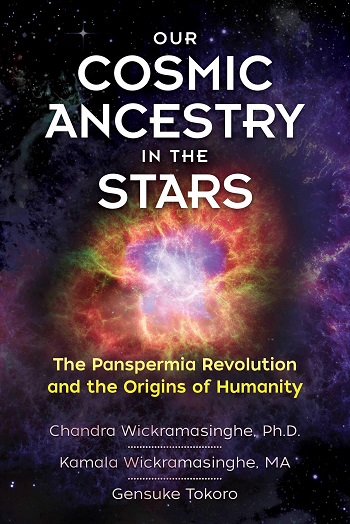 The newest book from Chandra Wickramasinghe et al. begins with the assurance that panspermia is how we humans came to be here on Earth. Now it is time to explore the implications of this paradigm. These include new possible causes for extinctions, diseases, evolutionary innovations and the rise and fall of empires. Indeed, the histories of science, philosophy and religion are all seen anew, with hopes that this awakening will make us more compassionate toward each other and more careful with our fragile planet. Overall, it is an impassioned plea for a fresh vision. Provocative, unorthodox and stimulating. We especially like the chosen title.
The newest book from Chandra Wickramasinghe et al. begins with the assurance that panspermia is how we humans came to be here on Earth. Now it is time to explore the implications of this paradigm. These include new possible causes for extinctions, diseases, evolutionary innovations and the rise and fall of empires. Indeed, the histories of science, philosophy and religion are all seen anew, with hopes that this awakening will make us more compassionate toward each other and more careful with our fragile planet. Overall, it is an impassioned plea for a fresh vision. Provocative, unorthodox and stimulating. We especially like the chosen title.
 Our Cosmic Ancestry in the Stars: The Panspermia Revolution and the Origins of Humanity, by Chandra Wickramasinghe, Kamala Wickramasinghe and Gensuke Tokoro, Bear & Company, 14 May 2019. Our Cosmic Ancestry in the Stars: The Panspermia Revolution and the Origins of Humanity, by Chandra Wickramasinghe, Kamala Wickramasinghe and Gensuke Tokoro, Bear & Company, 14 May 2019.
 Chandra Wickramasinghe has a background essay and updated links. Chandra Wickramasinghe has a background essay and updated links.
 A Biological Solution to the Mystery of Methane on Mars by Dirk Schulze-Makuch, AirSpaceMag.com, 09 Jan 2020. A Biological Solution to the Mystery of Methane on Mars by Dirk Schulze-Makuch, AirSpaceMag.com, 09 Jan 2020.
 Methanogenic Archaea Can Produce Methane in Deliquescence-Driven Mars by Deborah Maus et al., Scientific Reports, 08 Jan 2020. Methanogenic Archaea Can Produce Methane in Deliquescence-Driven Mars by Deborah Maus et al., Scientific Reports, 08 Jan 2020.
 Thanks, Theodore Rigley. Thanks, Theodore Rigley.
 Life on Mars! has links about methane there. Life on Mars! has links about methane there.
By 2020, in real or artificial life, sustainable evolutionary progress in a genetically closed system will not have been demonstrated. This was our online prediction of eighteen years ago. It has been upheld.

 Bet 44: our original posting, c. 09 May 2002, at
Long Bets of
The Long Now Foundation. Bet 44: our original posting, c. 09 May 2002, at
Long Bets of
The Long Now Foundation.
 3-5 Apr 2000: We ask NASA to look at this question. 3-5 Apr 2000: We ask NASA to look at this question.
 09 May 2002: our notice of the Long Bets prediction. 09 May 2002: our notice of the Long Bets prediction.
 The Evolution Prize, 2006, has elaboration. The Evolution Prize, 2006, has elaboration.
 In Real or Artificial Life, Is Evolutionary Progress in a Closed System Possible?
...I only want to draw attention to an important test that the standard theory has not yet met. In Real or Artificial Life, Is Evolutionary Progress in a Closed System Possible?
...I only want to draw attention to an important test that the standard theory has not yet met.
![]()
|
 The Emergence of Life has the most thorough discussion we have ever read on this topic. The various avenues of research get full and deep, updated presentation, enhanced with pictures, graphs and tables. Author Pier Luigi Luisi often includes conversations with primary research specialists when their fields are under discussion. Luisi is a biochemist at the University of Rome and a hands-on primary researcher himself, so he knows them.
The Emergence of Life has the most thorough discussion we have ever read on this topic. The various avenues of research get full and deep, updated presentation, enhanced with pictures, graphs and tables. Author Pier Luigi Luisi often includes conversations with primary research specialists when their fields are under discussion. Luisi is a biochemist at the University of Rome and a hands-on primary researcher himself, so he knows them.


 ...researchers have discovered living cells inside exceedingly old, cold oceanic crust in the middle of the South Pacific. It isn't yet clear how these new microbes are managing to survive–and yet, there seem to more than a million times more of them, for the same volume of rock, than in the younger crust.
...researchers have discovered living cells inside exceedingly old, cold oceanic crust in the middle of the South Pacific. It isn't yet clear how these new microbes are managing to survive–and yet, there seem to more than a million times more of them, for the same volume of rock, than in the younger crust.

 Did NASA's Curiosity rover photograph trace fossils on Mars? Barry DiGregorio thinks so. In a new book he analyzes enigmatic dark-toned features seen in Gale crater, comparing them to fossilized worm burrows on Earth. He also sees more evidence on Mars for "desert varnish," a biofilm that he has studied for years. He tells the story first-person, sometimes frustrated that NASA ignores promising leads. But his close attention to these forms on Mars and to Earthly trace fossils that look similar is, to our knowledge, unmatched.
Did NASA's Curiosity rover photograph trace fossils on Mars? Barry DiGregorio thinks so. In a new book he analyzes enigmatic dark-toned features seen in Gale crater, comparing them to fossilized worm burrows on Earth. He also sees more evidence on Mars for "desert varnish," a biofilm that he has studied for years. He tells the story first-person, sometimes frustrated that NASA ignores promising leads. But his close attention to these forms on Mars and to Earthly trace fossils that look similar is, to our knowledge, unmatched. The newest book from Chandra Wickramasinghe et al. begins with the assurance that panspermia is how we humans came to be here on Earth. Now it is time to explore the implications of this paradigm. These include new possible causes for extinctions, diseases, evolutionary innovations and the rise and fall of empires. Indeed, the histories of science, philosophy and religion are all seen anew, with hopes that this awakening will make us more compassionate toward each other and more careful with our fragile planet. Overall, it is an impassioned plea for a fresh vision. Provocative, unorthodox and stimulating. We especially like the chosen title.
The newest book from Chandra Wickramasinghe et al. begins with the assurance that panspermia is how we humans came to be here on Earth. Now it is time to explore the implications of this paradigm. These include new possible causes for extinctions, diseases, evolutionary innovations and the rise and fall of empires. Indeed, the histories of science, philosophy and religion are all seen anew, with hopes that this awakening will make us more compassionate toward each other and more careful with our fragile planet. Overall, it is an impassioned plea for a fresh vision. Provocative, unorthodox and stimulating. We especially like the chosen title.
 We welcome his observation that many genetic programs come from viruses. Nowhere does Shubin suggest that selection pressure caused any program to be invented on a blank slate (hooray!) And we were intrigued to know that William Bateson coined the term genetics, before the word gene was in use. The book is full of delight like that.
We welcome his observation that many genetic programs come from viruses. Nowhere does Shubin suggest that selection pressure caused any program to be invented on a blank slate (hooray!) And we were intrigued to know that William Bateson coined the term genetics, before the word gene was in use. The book is full of delight like that.
 Interestingly, the flu often seems to come from China — Hong Kong Flu, Asian Flu, and now COVID-19. Hoyle and Wickramasinghe had an intriguing hypothesis to explain this. Viral particles landing as cometary dust from above the atmosphere could take a year or more to drift down to Earth's surface. Wind turbulence can speed this up. The jetstream must bounce high in the stratosphere to pass over the Himalayas, Earth's tallest mountains. Downwind, the jetstream would descend again over the plain of China. There viral particles from space would likely first make landfall.
Interestingly, the flu often seems to come from China — Hong Kong Flu, Asian Flu, and now COVID-19. Hoyle and Wickramasinghe had an intriguing hypothesis to explain this. Viral particles landing as cometary dust from above the atmosphere could take a year or more to drift down to Earth's surface. Wind turbulence can speed this up. The jetstream must bounce high in the stratosphere to pass over the Himalayas, Earth's tallest mountains. Downwind, the jetstream would descend again over the plain of China. There viral particles from space would likely first make landfall.